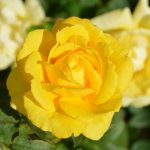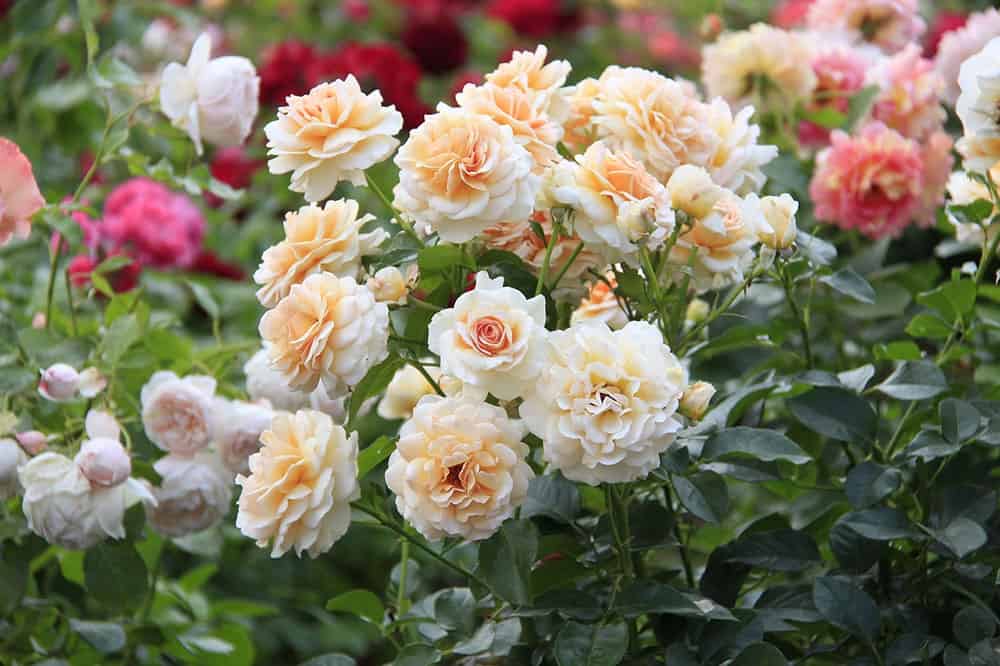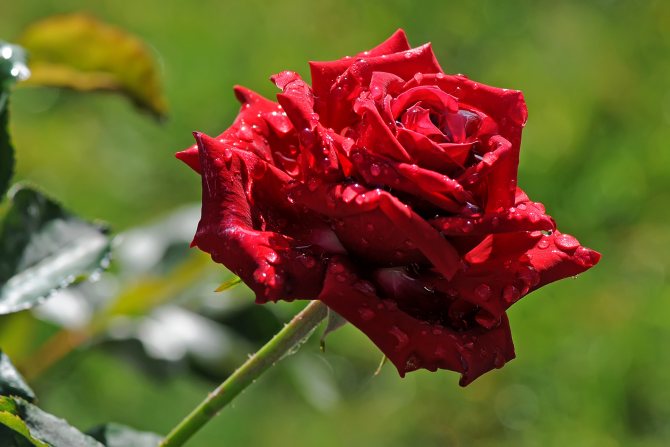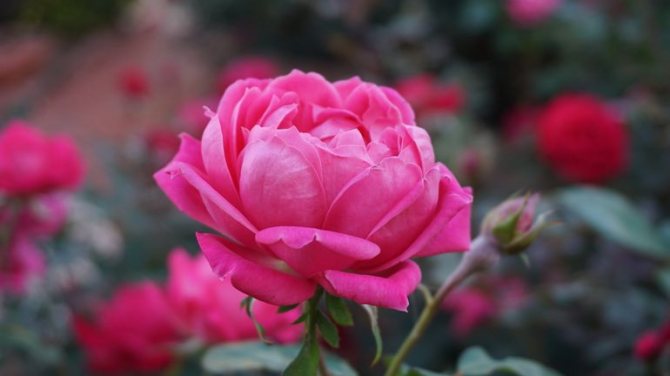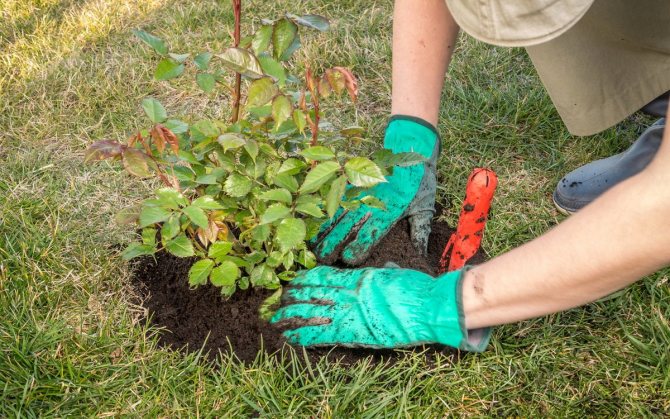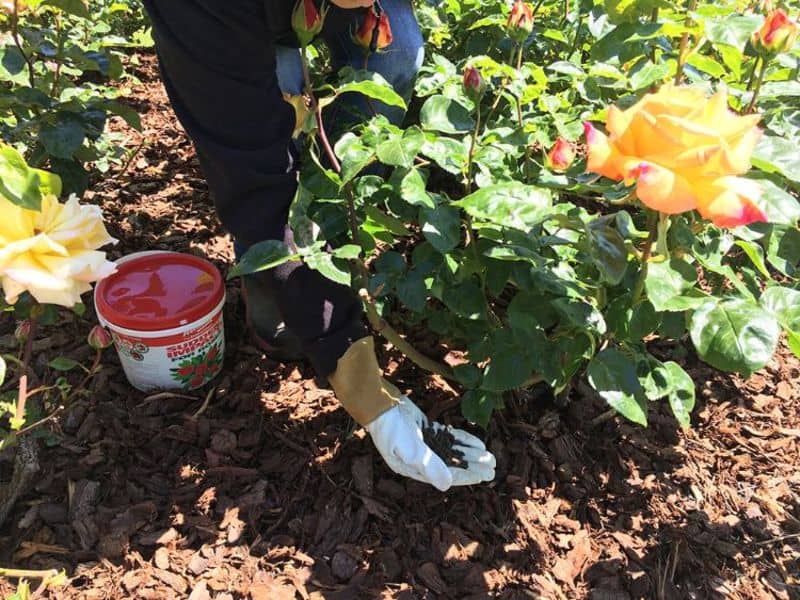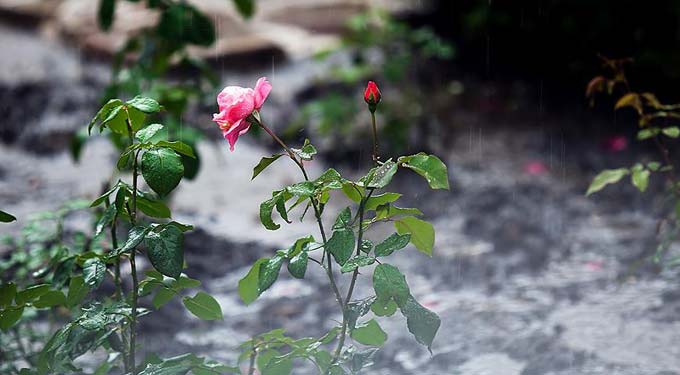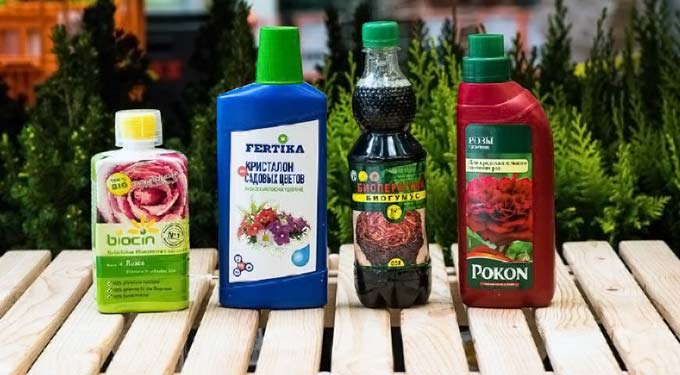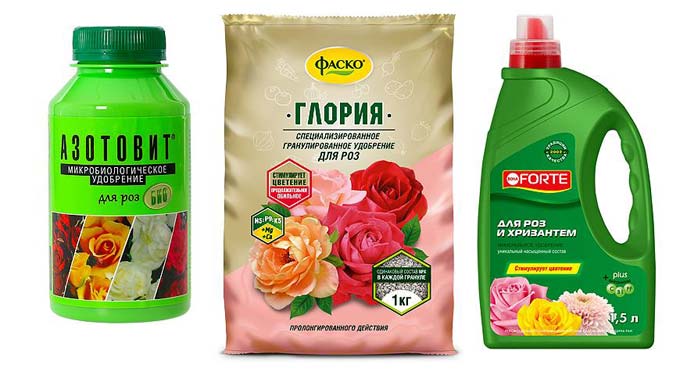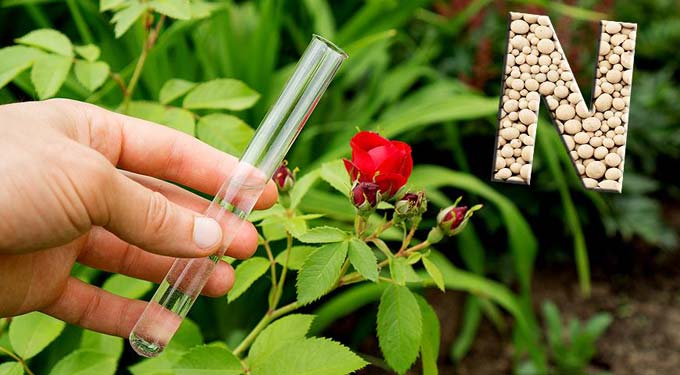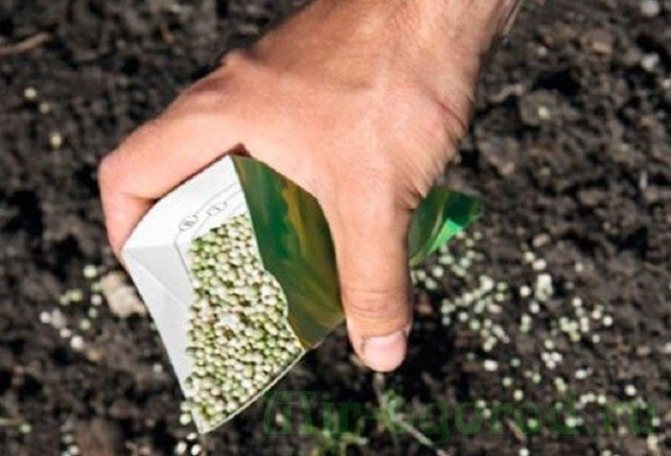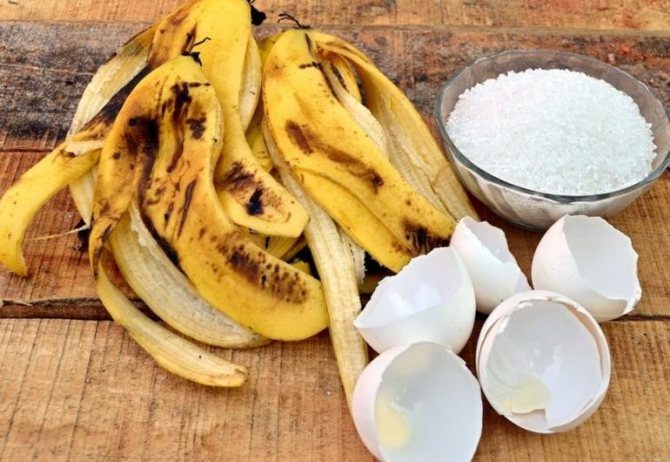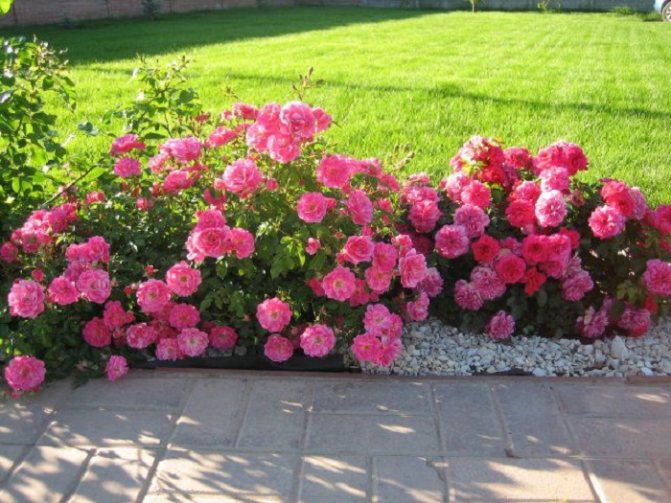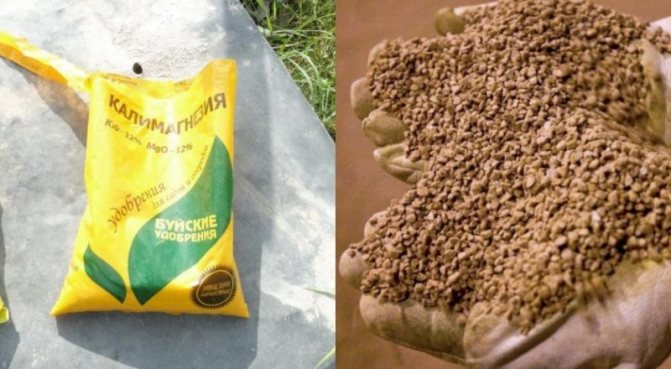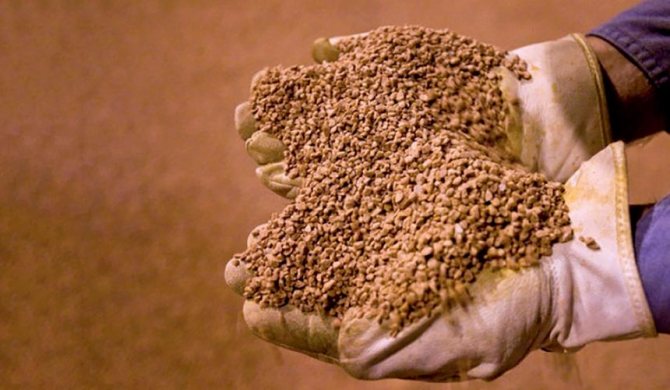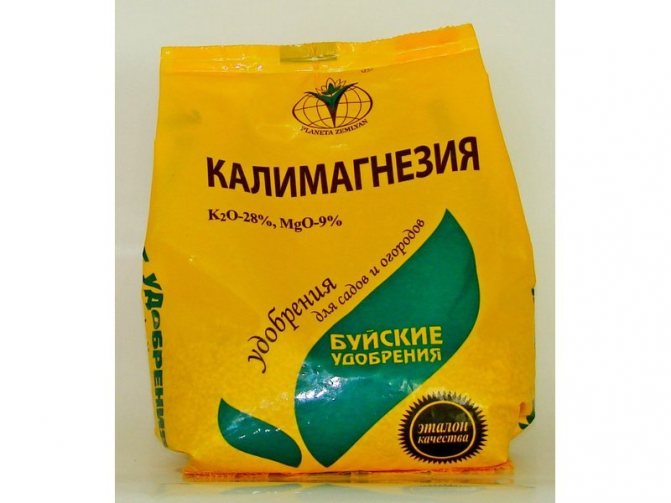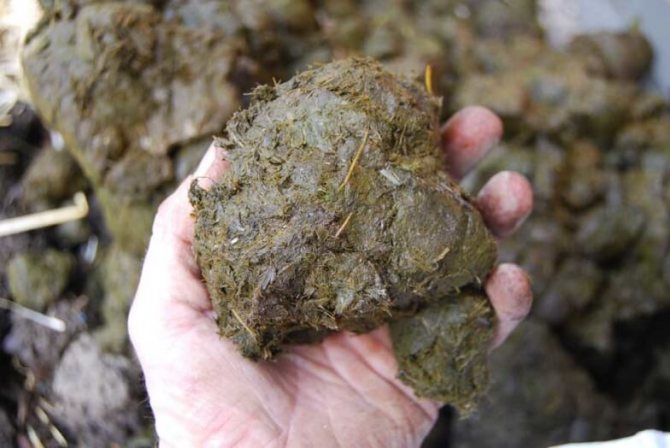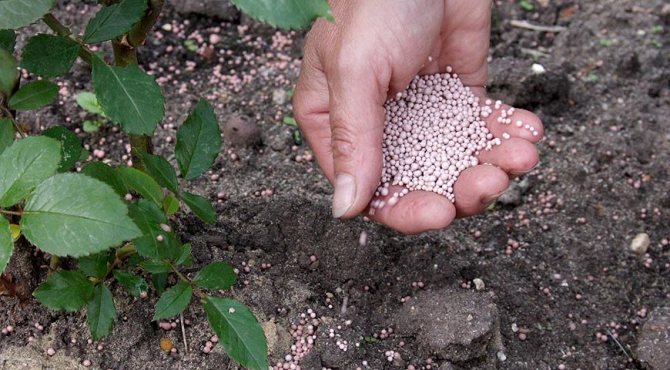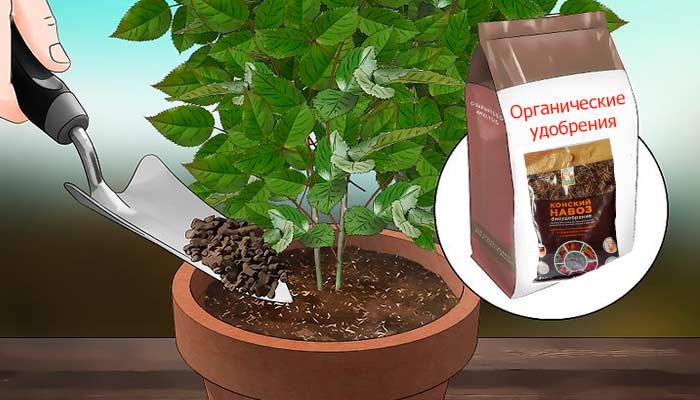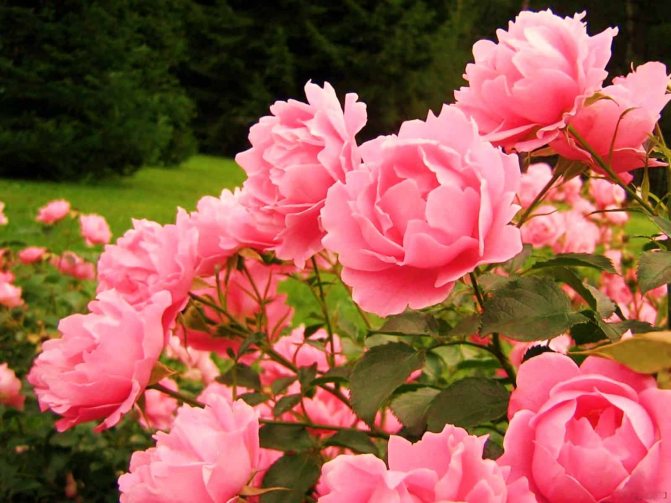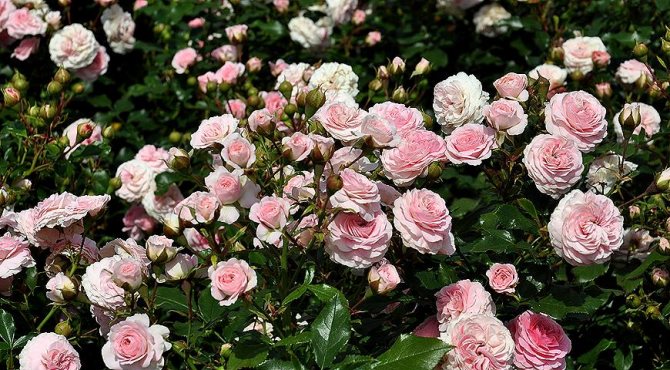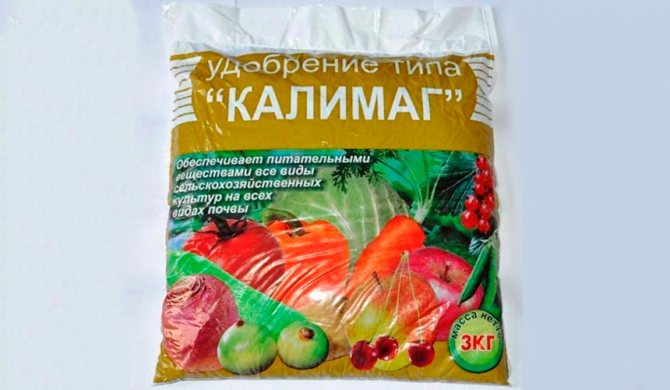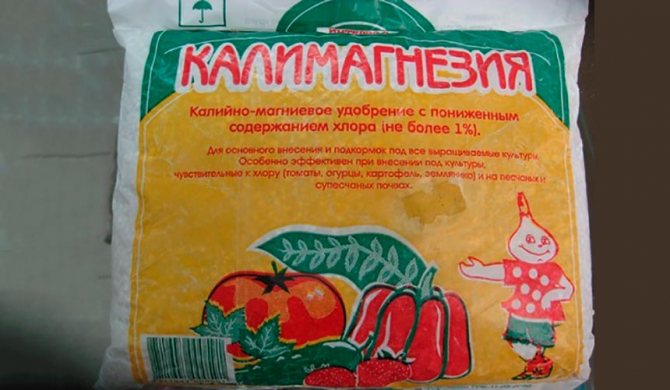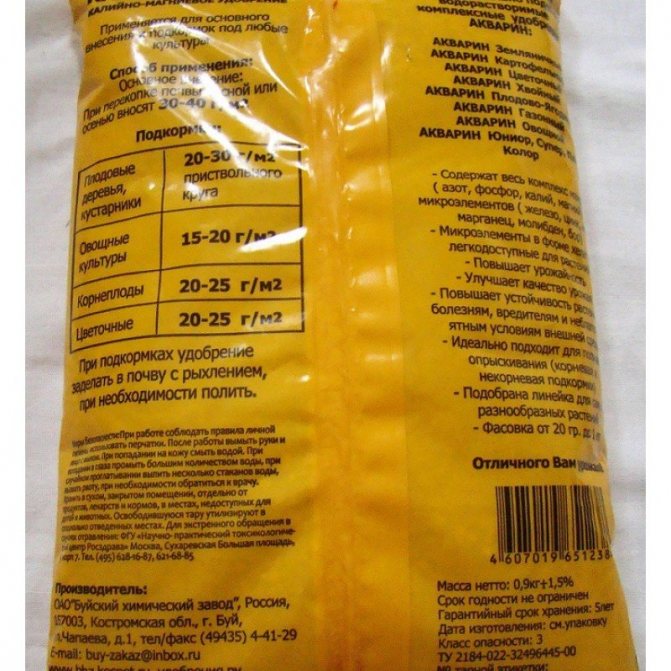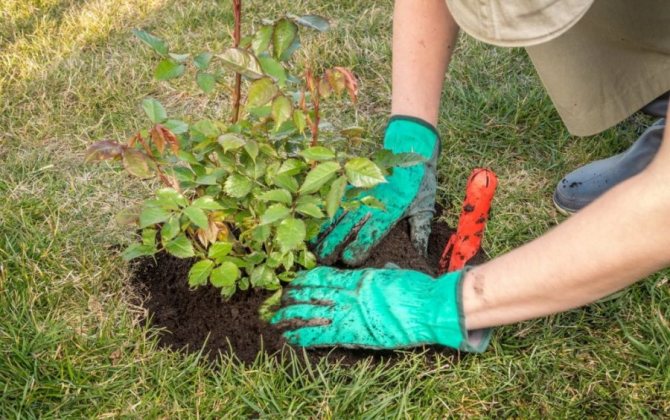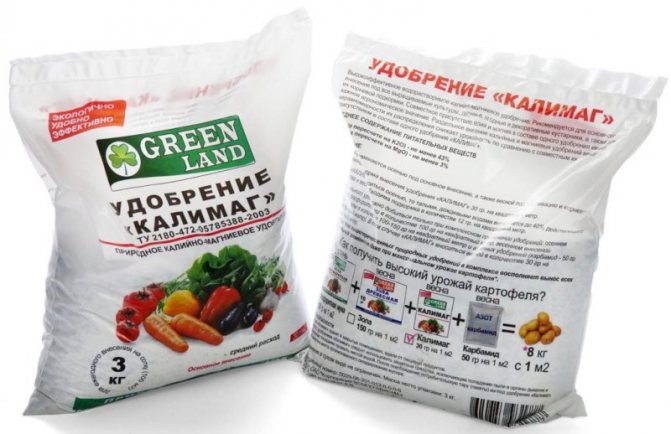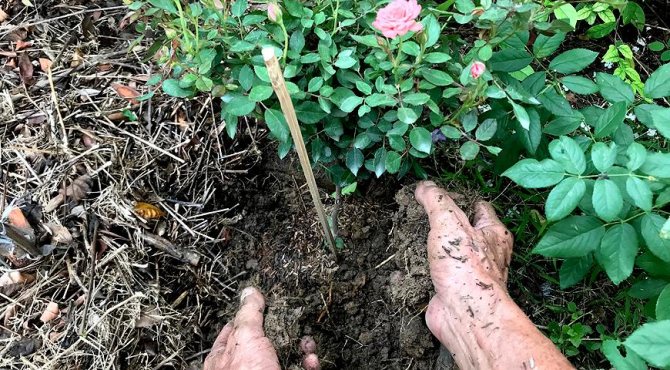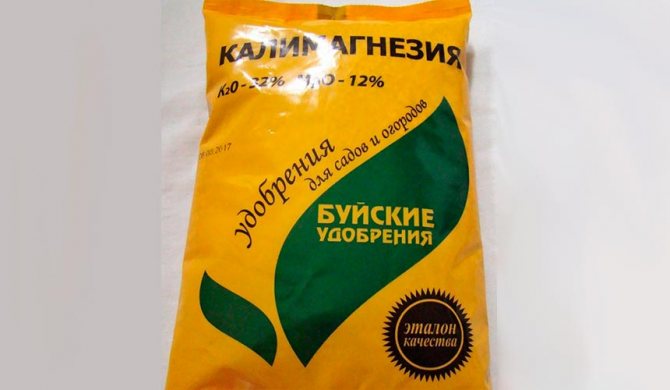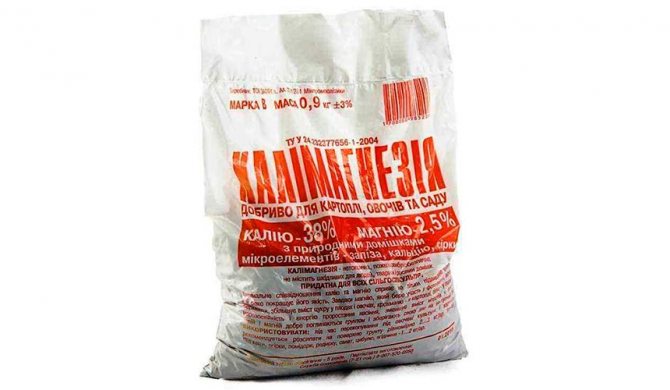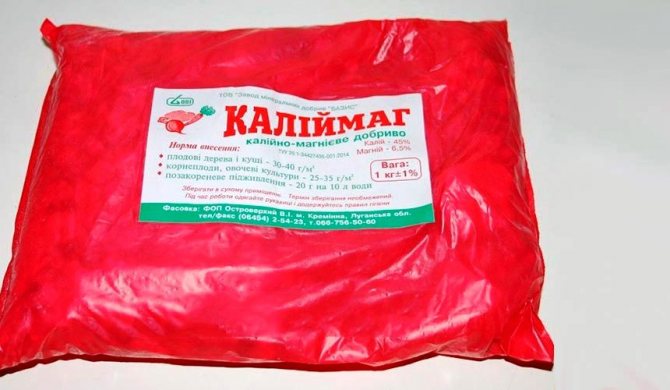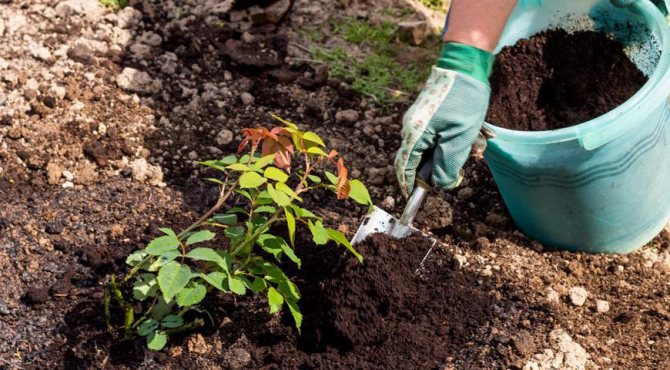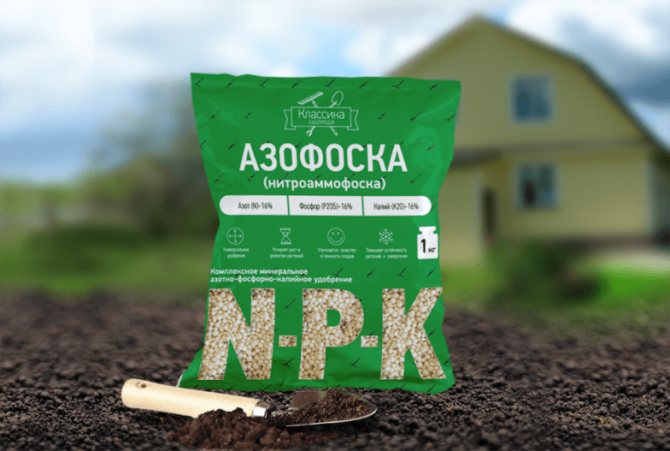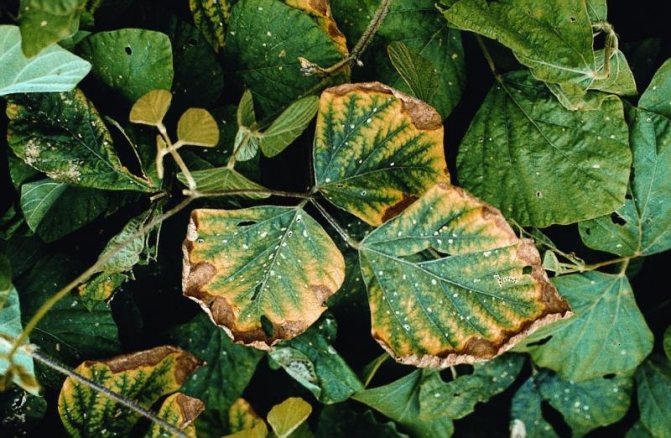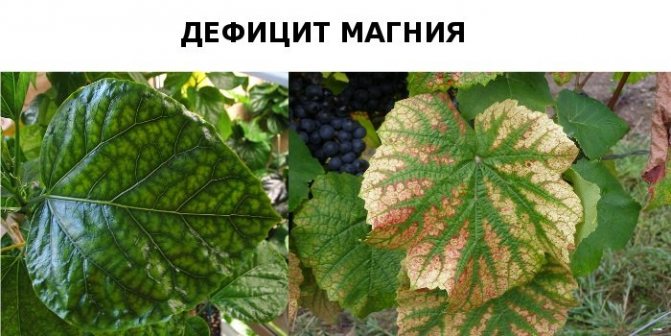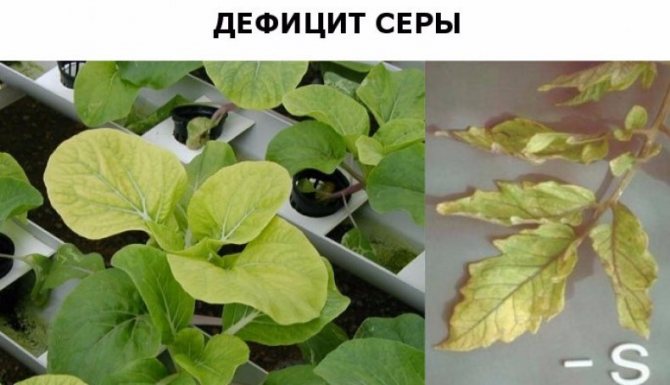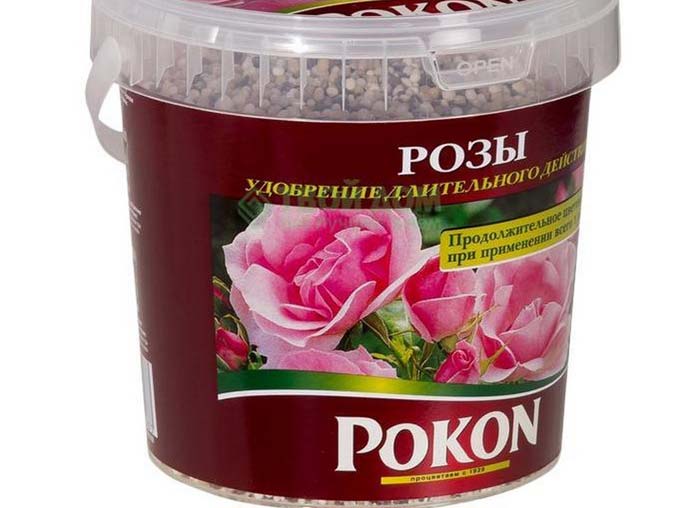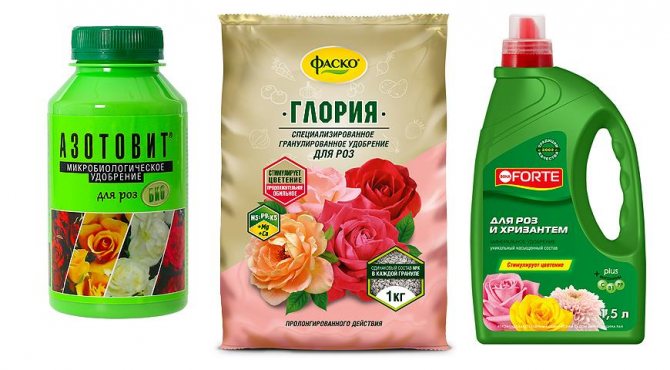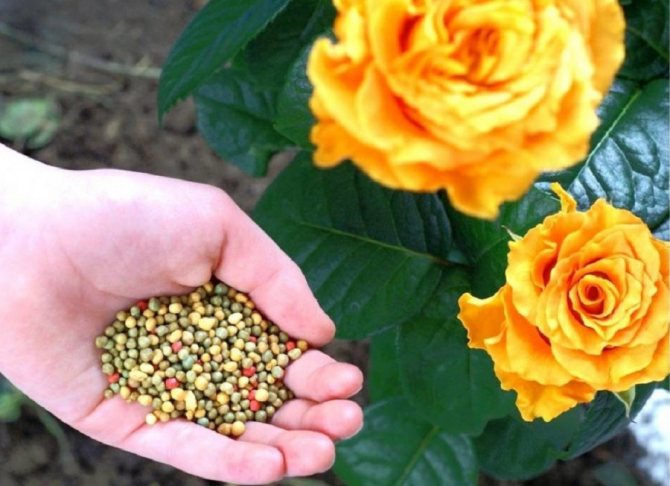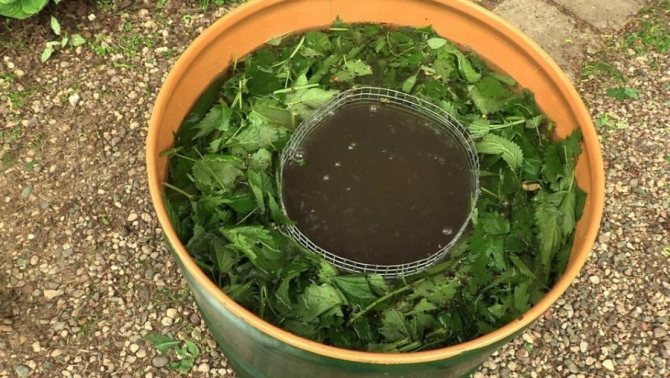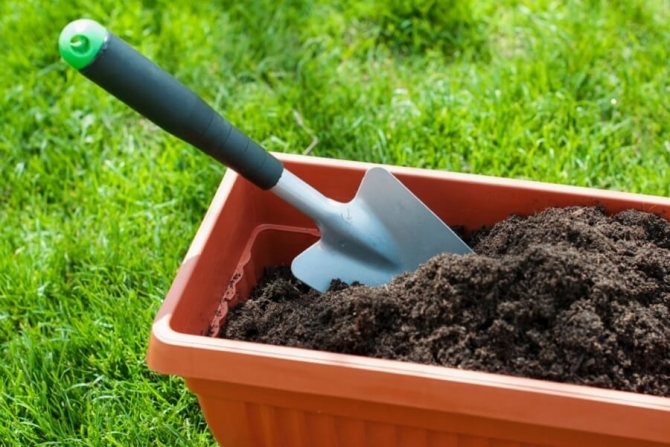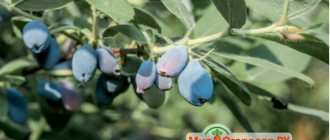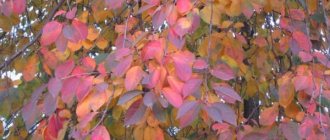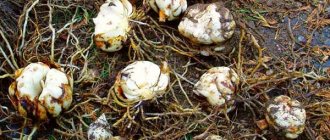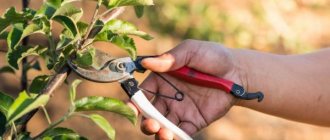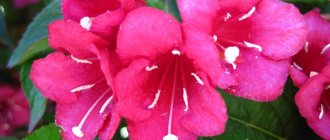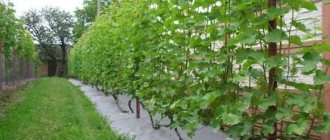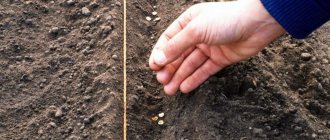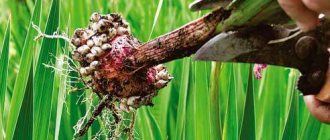In the life cycle of perennials, the onset of the cold autumn period is associated with a certain state of the plant, which cannot be ignored when caring for it. Growing roses also involves the implementation of mandatory autumn activities to prepare for winter. Fertilizing roses in autumn is one of them.
Do I need to feed roses in autumn
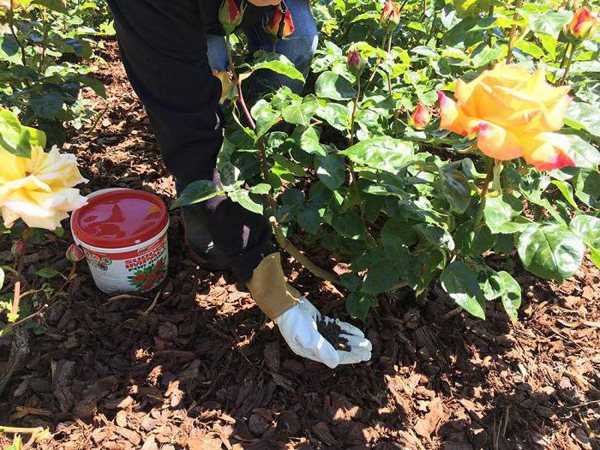
To help the plants overwinter in the frosty season, they are fed with potash and phosphorus fertilizers. It is these elements in sufficient quantities that increase the winter hardiness of the bushes. Balanced feeding with potassium and phosphorus will help roses accumulate plastic substances that prevent the stems from freezing in winter, and will also accelerate the ripening of the shoots. As a result, the branches become stronger and turn green. Unripe shoots are reddish in color. Such processes freeze out, so it makes sense to simply remove them at the point of growth a couple of weeks before frost.
In addition to its main value, the autumn feeding of roses helps to protect plants from diseases. Weakened bushes are known to be an easy target for diseases and pests. Strong bushes that receive all the necessary nutrients in a timely manner are not so often affected by them. In addition, for plants that have not accumulated plastic substances, cracking of the bark is characteristic of temperature jumps. In these cracks, pests and diseases usually settle, overwinter, and with the arrival of heat they begin their harmful activity.
Another reason for carrying out autumn feeding of roses is considered to improve the quality of flowering of bushes. Many fall fertilizers are long-lasting - the nutrients they contain are gradually transported to the roots of the roses and nourished over a long period. Along with this, the soil balance of nutrients is restored, which were drawn from the soil by plants during the flowering period.
Autumn feeding of roses is carried out in two stages:
- after flowering (late August - early September);
- pre-winter feeding (late September - early October).
The first top dressing is aimed at restoring the soil balance and structure, as well as accelerating the ripening process of the shoots. At the same time, fertilizers are applied to the soil in liquid or dry form, and the ground part is sprayed. The second feeding is aimed at protecting the root system from frost - compost is used for this purpose.
Fertilization stages and options
Fertilizers need to be applied in autumn in stages: after the end of flowering (mid - end of August) and from the last days of September to the end of October. The determining factors in the dosage of fertilizers are the condition of the plant, its age and the condition of the soil.
First stage
After the flowering period, the introduction of a solution of minerals will help to replenish the nutrients in the soil - potassium sulfate (30g) + superphosphate (100g) + 10l of water - at the rate of 10l for each adult bush. For young, not yet flowering, bushes, the amount of solution should be reduced by 2 times. Root feeding for them can be replaced with foliar feeding - spray with a solution of potash fertilizers.
If a sufficient amount of fertilizer is applied to the planting hole when planting, then re-fertilization is not required.
The lack of flowering in a rose of 2 or 3 years old indicates a lack of phosphorus.When it is introduced, an amendment should be made for the composition of the soil: heavy clay soil - reduce the amount, and on sandy lands - increase.
Reference! Lack of magnesium, nitrogen and potassium is observed in sandy loam soils, copper and molybdenum in peat soils, iron in clay soils, manganese in chernozems.
Second phase
At this stage, it is convenient to use rotted compost, and wood ash will enhance its effect. The resulting mixture should be sprinkled with the already cut bush and the soil around. With this method, nutrients enter the soil gradually, transforming into a form that is convenient for assimilation. In addition, the compost layer has a protective function - it protects the root system from frost.
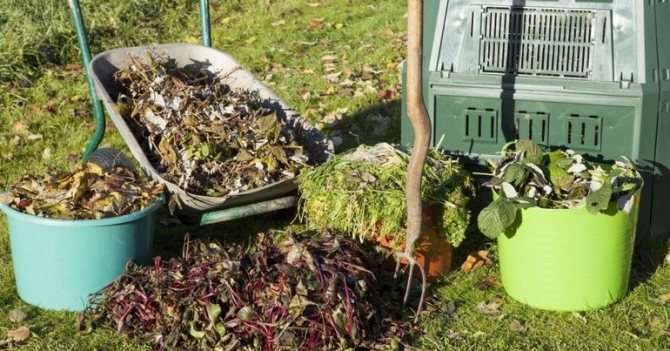

For autumn dressing, it is quite possible to prepare high-quality compost in 3-6 months using the preparation Baikal EM1.
How to quickly compost:
- put any plant residues and food waste in the designated place - the variety of components increases the nutritional value;
- add straw, peat, sawdust that has begun to sweep - they retain moisture;
- sprinkle each layer with earth and pour the preparation prepared according to the instructions.
Information! A big plus of such compost is that the preparation destroys the pathogenic environment, which minimizes the risk of contamination of the plant with harmful microorganisms.
Other feeding options:
- potassium sulfate (1 tablespoon) + potassium phosphate (2 tablespoons) + boric acid (1/2 tsp) + 10 liters of water - in warm regions, water in the first and last decade of September, in cold regions - in the last decade of August and the first decade of September;
- potassium monophosphate (1 tbsp. l.) + superphosphate (1 tbsp. l.) + 30 l of water - spray the bushes in late August and late September (early October);
- "Autumn" balanced universal complexes - potassium monophosphate, Autumn Kemira (NPK 4.8: 20.8: 31.3 + micro), Kemira Lux, Fertika Autumn.
If desired, before sheltering a rose for the winter, you can put phosphorus fertilizers in granules into the soil and scatter 1 glass of ash around the bush or scatter ash (1 glass) and double superphosphate (1-2 tbsp. L.), Followed by mulching with rotted manure.
How to feed roses in the fall before sheltering for the winter
Autumn feeding of roses consists in the introduction of potassium and phosphorus, which will help the bushes to prepare for wintering in a natural way. Distinguish between organic and mineral fertilizers, which contain these elements in increased quantities.
Folk remedies
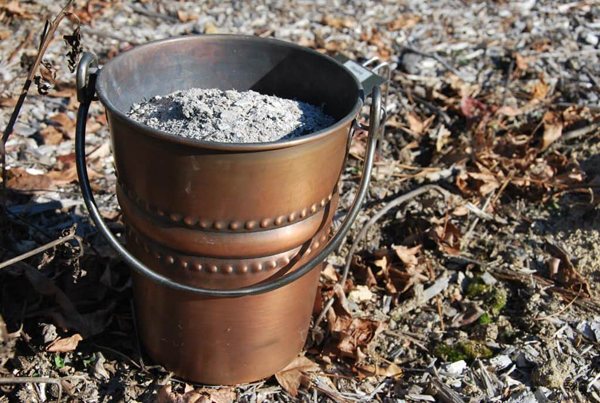

Folk remedies used to feed roses are fertilizers that do not contain chemicals. In the autumn period, many of them cannot be brought in. This applies to organic fertilizers containing a high proportion of nitrogen, for example, herbal infusions, manure, poultry droppings, etc. Since roses need potassium-phosphorus nutrition in autumn, proponents of organic farming use ash and compost.
- Ash. In the autumn period, ash for roses is simply necessary - it contains potassium, phosphorus and many essential trace elements. Ash dressings can be applied in different ways:
- dry;
- spraying;
- watering at the root.
In the first case, ash is simply scattered under the bushes, while lightly covering it with earth so that light particles of fertilizer do not erode. Dry ash consumption will be 3 l / m 2. In order for the roses to quickly assimilate the nutrients in the dressing, you can prepare an ash solution and spray it on the aerial part of the bush. For this, 200 g of wood ash are bred in a bucket of water. For root watering of roses with an ash solution, its concentration is halved: 100 g of ash is added to a bucket of water.
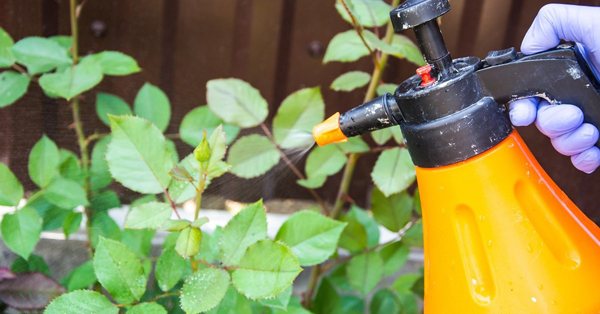

- Compost. Over-matured compost, scattered under rose bushes, will serve not only as an excellent fertilizer with a long period of action, but also as additional protection of the root system from frost. It is scattered without embedding it in the soil.Gradually, the beneficial substances contained in the compost will pass into an easily digestible form for plants.
- Banana peel. Banana skins are considered a natural source of potassium, so gardeners drop them near rose bushes. In this case, you can use both fresh and dried peels.
Yeast is considered an excellent food for roses. Despite the fact that yeast root dressing of roses has a good effect on their growth and flowering, it is not recommended to use them in the autumn period: the shoots will begin to grow actively, do not have time to get stronger and will die from frost. Therefore, yeast is introduced exclusively in spring, summer.
Mineral fertilizers
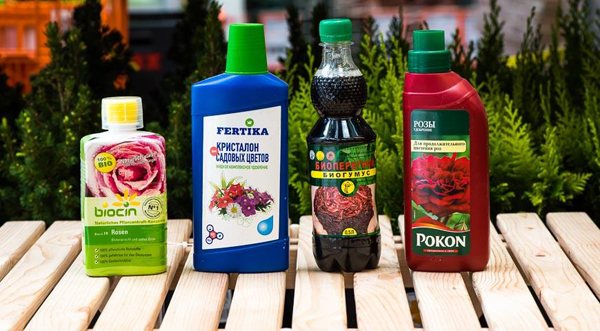

Mineral fertilizers are the best suited for the autumn feeding of roses. It is recommended to use complex granular fertilizers containing potassium and phosphorus. The variant of the complex water-soluble universal fertilizer "Autumn" is very convenient. It contains all the necessary elements in optimal proportions. Such dressings are produced by many manufacturers, the most popular of them are considered below.
OMU "Osennee", Buisk chemical plant. Granular fertilizer of prolonged action, which is applied exclusively in dry form and embedded in the soil at a shallow depth. Composition: phosphorus - 5%, potassium - 10%, nitrogen - 2%, trace elements. Consumption - 25 ... 40 g / m 2.
Autumn fertilizer from the Fertika company (kemira). The composition of the granular fertilizer: nitrogen - 5%, phosphorus - 21%, potassium -31%, trace elements. Fertilizer consumption is 30 ... 40 g / m 2.
Fertilizer autumn from Fasco. Universal granular dressing with phosphorus content - 15%, potassium - 35%, nitrogen - 5%. Consumption depends on the method of application: as a liquid top dressing - 10 ... 30 g / m 2, dry method with embedding in the ground -30 ... 60 g / m 2.
All these fertilizers do not contain chlorine, which is their undoubted advantage. But they contain a small proportion of nitrogen, not all summer residents like it. On the other hand, a nitrogen content of up to 5% in fertilizers is considered the norm, since it is this element that helps plants to absorb phosphorus.
Agrecol is an autumn fertilizer that does not contain nitrogen at all. It contains potassium - 27% and phosphorus - 13%. The consumption rate is 30 ... 40 g / m 2. This fertilizer can be used if there is an excess of nitrogen in the soil composition.
Other mineral fertilizers:
- Potassium monophosphate - contains phosphorus (50 ... 55%) and potassium (33%);
- Potassium sulfate (potassium sulfate) - fertilizer containing 50% potassium;
- Superphosphate - contains phosphorus (up to 20%), sulfur, magnesium, calcium. Double superphosphate has a high phosphorus content of –43 ... 46%.
Effect of potassium, sulfur and magnesium on roses
Chemically, potassium magnesium is a double salt - a compound of potassium sulfate and magnesium sulfate. Thus, it gives roses three mineral elements - potassium, magnesium and sulfur, so potassium magnesium can be attributed to complex mineral fertilizers.
The lack of these substances quickly enough affects the state of the roses:
| Mineral element | Deficiency symptoms |
| Potassium |
|
| Magnesium |
|
| Sulfur |
|
Sulfur and magnesium play an auxiliary role in biochemical processes, and potassium
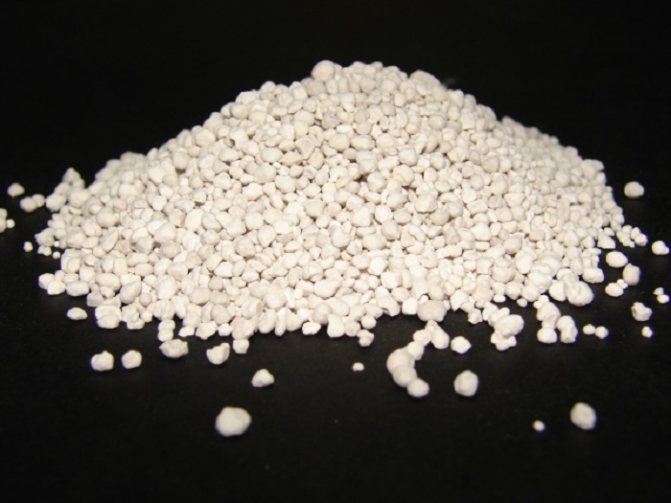

Kalimagnesia is a powder or small granules of grayish, pinkish or brick color, readily soluble in water.
refers to the main batteries (
How to feed roses in the fall after planting and is it necessary
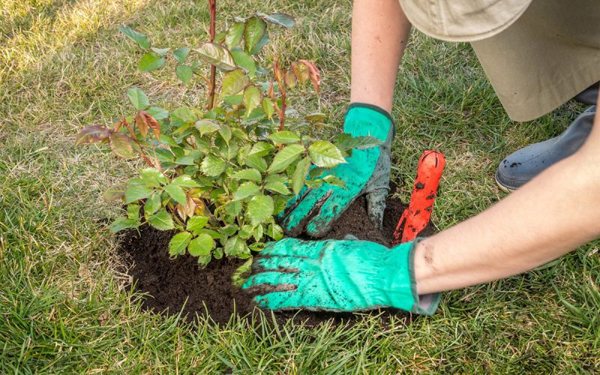

Experienced gardeners start planting roses in the fall: new bushes, if they survive their first winter on the site, will bloom the next year. The main problem of planting roses in autumn is to speed up the preparation for winter, so that new bushes adapt and take root as quickly as possible, and the shoots mature and do not freeze during frosts. For this purpose, some gardeners put potash-phosphorus fertilizers in the planting pit. However, this must be done very carefully, since direct contact of the root system of the seedling with fertilizers ends with a burn of the root hairs.
It is not recommended to fill the planting pit with compost. Its composition is always different, so it is impossible to predict whether the compost will harm the planted roses.When planting, the pit is filled with a nutritious loose substrate, which will be enough for the normal adaptation of roses in a new place: sod soil is mixed in equal amounts with decomposed rotted manure, ash is added.
In what form to apply
Manure has several degrees of decomposition. It happens:
- fresh;
- semi-rotten;
- rotted;
- humus.
Fresh
The percentage of macronutrients in it is high, but they are practically not assimilated by plants, since they are there in organic form. In addition, it is heated to high temperatures and can burn the roots.
Semi-mature
It is already less aggressive than fresh. The amount of macronutrients in it has decreased, but their digestibility has increased.
Overripe
Such manure becomes crumbly. They can mulch roses.
Humus
The last degree of maturity. He's the most helpful. It is difficult to harm the plant with humus. A suitable option for fertilizing the soil and feeding rose bushes.
Tips from seasoned gardeners
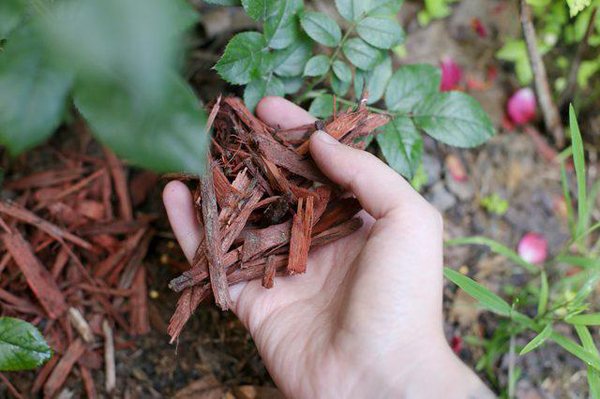

Gardeners involved in the cultivation and breeding of roses know a lot about carrying out autumn dressings, so they can give a lot of interesting and useful advice to beginners.
- When choosing the method of fertilization, it is recommended to be guided by weather reports. If the autumn is rainy and damp, liquid watering with a solution under the root and spraying over the foliage will be ineffective and useless. In addition, they can provoke the emergence of pests and diseases for which high humidity is considered a favorable environment.
- Many phosphorus-containing fertilizers need to be diluted in a small amount of warm water, and then brought to the required volume with the remaining amount of liquid. The fact is that phosphorus fertilizers, for example, superphosphate, dissolve very poorly.
- In no case should unripe manure and droppings be used for pre-winter feeding of roses instead of compost. They contain an increased amount of nitrogen, which will provoke active growth of shoots.
- The most optimal way to apply dry fertilizer is in the furrows. To do this, at a distance of 15 cm from the stem, they carefully make a shallow annular groove and fill it with a mixture of soil and granular fertilizers. During rains and watering, all nutrients will gradually flow directly to the sucking roots of the rose.
Knowing some of the nuances of the autumn feeding of roses, you can help them prepare for wintering and at the same time improve the composition of the soil.
How to feed roses for winter: video
Rose is a fastidious and demanding culture, but its gorgeous bloom more than compensates for all the efforts and expended time and effort. In order for the flowering of the rose to be beautiful and lush next year, and the bush to endure the winter without loss, it is necessary to feed it with potassium and phosphorus in time.
Top dressing of roses in autumn is a measure that will allow you to get very rich and beautiful flowering next year. But in order to carry out top dressing correctly, you need to know what fertilizers can be used.
Organic fertilizer for roses
From organic only fertilization with fresh manure is prohibited, as it can burn the roots of roses... All other nutrients are welcome.
Peat or plant compost is periodically poured under the roses. The rest of the fertilizers are applied together with water in the correct proportions.
If you want to fertilize with fresh chicken droppings, then you should dilute it 1:20 with liquid, if with the old, then 1:10.
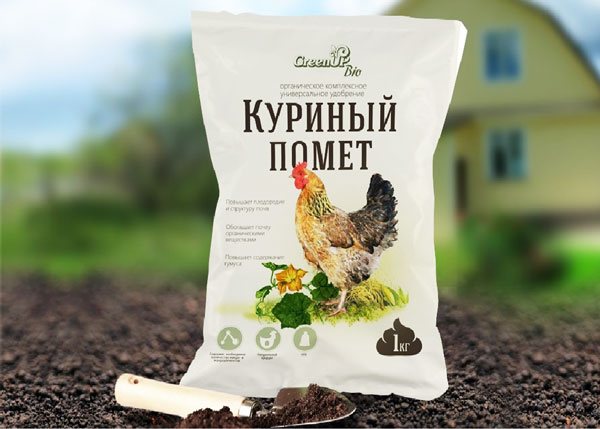

This organic fertilizer must be left in a dark place for five days before use, and then diluted with water in a 1: 3 ratio.
You can also use cow's infusion, which must first be diluted 1:10 and after standing in a dark place for about a week, diluted with water in equal proportions.
Fertilizing roses with manure is most often used, however, if it was not at hand, weed can be used... To do this, its leaves and stems are very finely crushed, well tamped, and covered with water. Leave the fertilizer in a dark place for 10 days, dilute with water 1:10, and water the bushes.
For a higher efficiency of the above solutions, you can dilute superphosphate or wood ash in 50 liters of water.
A good option as a fertilizer for roses is coffee or blood meal... Such products contain many trace elements necessary for flowers, they contribute to the good development and flowering of bushes.
Why do you need autumn feeding
Not every garden plot in the middle lane can boast of fertile soil. In addition, even if the rose bushes are planted on good soil, it still depletes over time. During the period of spring and summer flowering, the rose very actively consumes nutrients from the soil - and, accordingly, by autumn there are very few of them.
Autumn feeding allows you to:
- to enrich the impoverished soil and supply roses with useful substances;
- strengthen the root system of the plant before leaving for winter dormancy;
- give the rose the strength necessary for the plant to recover, including after the autumn pruning;
- strengthen the plant's immunity to diseases and pests;
- increase the cold resistance of rose bushes and prevent them from freezing in winter.
Correctly performed autumn feeding of roses and preparation for winter promotes rapid growth of rose bushes in spring - and their abundant flowering.
Why is feeding in the fall so important?
In the summer, during the period of abundant flowering, the rose consumes a lot of nutrients for the formation of deciduous mass and directly on the inflorescence itself. During this period, she needs a sufficient amount of organic and mineral substances rich in nitrogen, iron and magnesium.
During the warm summer period, the rose depletes itself very much and feeding in the autumn is simply necessary for the plant to overwinter as comfortably as possible. The main thing here is to choose the right composition of nutrients. Firstly, it is necessary to exclude the elements that could be fed in the summer, otherwise the rose will not have time to prepare for the cold weather, and all the time will give vitality to growth under the influence of organic substances. Secondly, dressing in late autumn still serves as protection against freezing and pests.
Root
The method consists in the fact that fertilizers are applied in the fall directly to the soil near the plant. Useful substances are taken by the root system - and from it they are carried further throughout the plant. Thus, the roots, and the stems, and the leaves receive nourishment - and at the same time, very little time is spent on feeding.
Root feeding can be:
- liquid - in this case, minerals or organic matter are dissolved in water and the plant is watered with the resulting composition;
- dry - dry fertilizers are either laid in small grooves dug in the ground, or simply scattered over the surface, and then sprinkled with earth.
Kalimagnesia: manufacturers and prices
Kalimagnesia is produced by many manufacturers of agrochemical products:
| Manufacturer | Trade name of the drug | average cost |
| "Buy Fertilizers" | "Kalimagnesia" | 56 rubles for 0.9 kg |
| "Healing salts of Prikamye" | "Kalimag" | 75 rubles for 1 kg |
| "Green Land" | "Kalimag" | 120 rubles for 3 kg |
| "BioMaster" | "Kalimag" | 49 rubles for 1 kg |
The drugs that are produced under the brand name "Kalimag" chemically represent ordinary potassium magnesium. The difference in price between manufacturers depends on the packaging of the fertilizer and the marketing investments of the company. There is no difference in efficiency.
Tip # 1. It is noticed that the efficiency of potassium magnesium on acidic soils increases with simultaneous liming of the soil. Therefore, a number of manufacturers produce calcined Kalimag, which combines two operations into one.
Foliar
Foliar dressing involves spraying the top of the plant with a spray bottle. Most often it is used as an addition to the root method. But sometimes foliar feeding can be applied separately - for example, if useful substances have already been introduced into the soil quite recently.
Fertilizers in this case are absorbed by the surface of the leaves. The main advantage of foliar feeding is that the effect occurs very quickly. This can be important if feeding is aimed at controlling a disease.
Fertilization calendar, when to start and how to end
Spring is the best time to properly fertilize your plants.... As for the frequency of dressings, they should be carried out approximately once every two to three weeks.
The first fertilizers should be applied after the first pruning of the bushes, when the buds are just beginning to open. It is recommended to feed the second time when the leaves begin to appear.
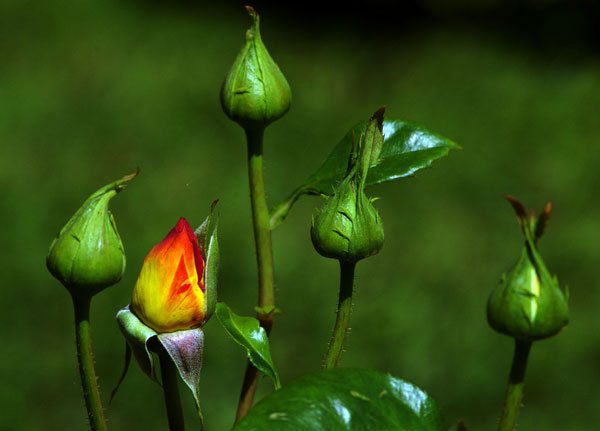

The third time is when the buds begin to open. No later than mid-September, there should be the last dressing of roses for the season.
By adhering to these simple rules when applying fertilizers, your roses will always delight with lush and long flowering.
What do roses need in spring and summer?
During this period, active growth begins, therefore, in spring and summer, it is simply impossible to do without fertilization. The first top dressing should be done in the spring after pruning.
The best fertilizer for roses in the warm season is as follows: dissolve fifty grams of superphosphate and ammonium nitrate in a bucket of water and spray the bushes. You can also purchase the drug Pocon.
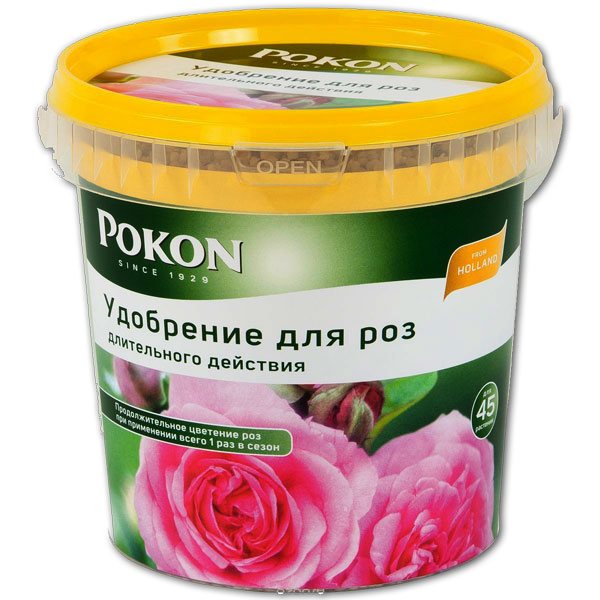

You can also use humus; for this, manure with complex fertilizer is placed near the shoots. The second feeding starts around May. It is best to use ten grams of nitrogen, the same amount of potassium salt and twenty grams. superphosphate.
With the beginning of summer, when the buds already appear on the plants, they carry out the next top dressing, with the same composition that was used in the spring.
At the end of summer, it is advisable to add twenty grams of potassium salt and forty grams. superphosphate. Ash, infused with water, is most often used between dressings in the form of spraying the bushes.
To prepare it, you need to take one hundred grams of ash and fill it with hot water (about two liters). Leave in a dark place for a day, then drain the infusion from above, and bring the volume to five liters.
In this video, the expert talks in detail about how and with what to feed a rose when planting, in spring and summer during flowering:
Autumn feeding of roses
Of course, the plant must be properly prepared for winter so that it can withstand severe frosts. The first time the roses are fertilized at the end of summer, and the second at the end of September.
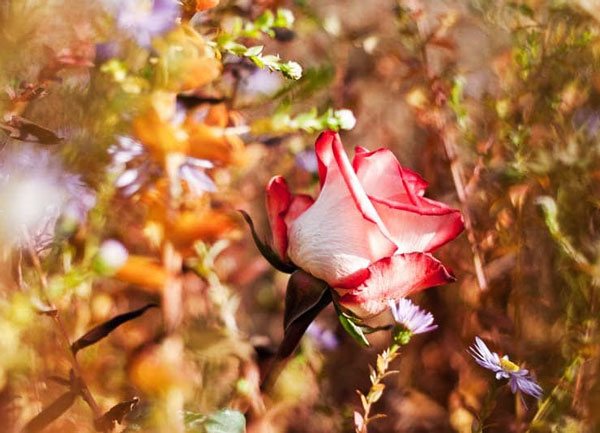

At this time of year, it is necessary to stop using nitrogenous substances so as not to stimulate plant growth. In addition, it is not recommended to add manure before winter, as this will cause the plant to release new shoots, which will take away extra strength from the flowers.
How to fertilize roses in autumn
To feed roses in autumn with fertilizers, a very wide range of useful mixtures and substances, both mineral and organic, is used. But they need to be applied not at random, but only clearly understanding what this or that feeding is needed for.
Organic fertilizers
The advantages of organic fertilizers are that with each of them, roses receive a whole range of useful substances. In addition, the effect of feeding is extended over time - valuable substances continue to feed the plant until spring.
Wood ash is a very popular fertilizer for rose bushes aficionados. It contains primarily potassium and calcium, and both of these elements are extremely important for the rose on the eve of winter.
As a rule, ash is applied under the roots of a rose bush. It can be diluted in water in the amount of 100 g per 10 liters of liquid, or you can simply sprinkle dry ash on the ground - about a three-liter can of fertilizer will take per square meter.
Compost
Compost is an organic mixture of fallen leaves, weeds and tops obtained as a result of overheating. This mixture contains almost all the substances necessary for roses in autumn - potassium and phosphorus, a small amount of nitrogen and other elements. The compost is scattered near the roots of the plant in the amount of several kilograms per square meter.
An important advantage of organic fertilizer is that compost additionally acts as a heat-insulating layer and protects the roots of bushes from hypothermia. Therefore, it is better to introduce it in late autumn, just before the onset of cold weather.
Onion peel
An unconventional but very useful fertilizer for roses is regular onion peel. It contains the richest vitamin complex necessary for roses in autumn - vitamins C and B, carotene, phytoncides. Husk not only strengthens plants, but also helps in the fight against insect pests.
Most often, the husk is used in liquid form. For example, you can cook:
- broth - onion peel is tightly stuffed into two glasses, a measured amount is poured into 10 liters of water, boiled and then insisted for another 4 hours;
- infusion - 0.5 kg of husk is poured into 2 liters of warm water and insisted under a lid throughout the day.
Fertilizer can be poured under the root of a rose bush, or you can spray it on the leaves of the plant if feeding is carried out before the leaves fall.
In addition, onion hulls are often added to compost to create an improved mulching mixture that can be used before winter comes.
Manure
Fresh manure is an excellent classical fertilizer containing a full range of macro- and microelements - nitrogen and potassium, phosphorus, iron and manganese, magnesium and boron. In order for it to bring the maximum benefit to the rose bushes, it is first subjected to overheating - that is, they put it in storage and wait until it turns into humus.
Rotted manure is usually used at the beginning of autumn, fertilizing the soil under the roses with several kilograms of top dressing per square meter. Manure acts as a mulch and protects the plant roots from frost.
Bird droppings
Poultry manure is a fertilizer with a high nitrogen content. This means that it is undesirable to use it in the fall, at least in high doses. Nitrogen fertilization can provoke a rose to grow actively, while in the fall, on the contrary, it needs to plunge into a state of rest.
If the plant still lacks nitrogen, and you need to feed the rose in the fall, then it is better to use bird droppings in early September - and in small quantities. Then nitrogenous compounds will have time to be absorbed by the plant, and the transition to the state of winter dormancy will take place normally.
Eggshell
Eggshells contain a lot of calcium, which is good for rose bushes. Such dressing loosens the soil and improves its structure, promotes better ventilation of the roots, and lowers soil acidity.


Fresh shells are used both dry and in the form of an infusion.
- In the first case, you just need to dry the shell, then crush it into small crumbs and sprinkle the earth around the rose bushes - in the amount of 1 - 2 cups per square meter.
- In the second case, the shell of 4 eggs is poured with a liter of boiling water, and then insisted for 5 days, stirring daily. The resulting solution is poured under the root of the rose.
Mineral fertilizers
Both at the beginning and at the end of autumn, special mineral supplements can be used to feed the roses. The effect of them is faster and more concentrated. Such fertilizers are especially good for dealing with specific problems - for example, to restore a plant after a disease, or to purposefully enrich the soil with some substance.
Potash fertilizers for roses in autumn
Top dressing with potassium is one of the most important for a rose in the fall. Potassium helps, first of all, to increase the frost resistance of the plant, strengthens the immunity of bushes to diseases and pests, enriches the soil and guarantees a large number of buds for the next year.
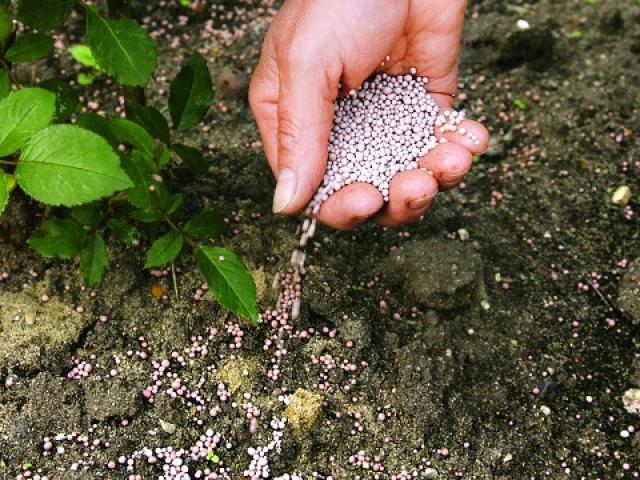

For feeding, the following potassium preparations are mainly used.
- Potassium sulfate is one of the best potassium fertilizers for fall. It has a strengthening effect, but does not contain chlorine, therefore it can be used directly in the preparation for winter.
- Potassium magnesium. The additive contains potassium in a volume of 30% and magnesium oxide - 10%. Well suited for feeding in autumn, especially successfully enriches light sandy soils.
There are other drugs - potassium chloride, potassium nitrate. However, it is better to use them in the spring or on soils where the planting of a rose is only planned.
Phosphate-potassium fertilizers for roses in autumn
Another extremely useful top dressing in the fall is made with the help of phosphorus-potassium fertilizers. If potassium is responsible for increasing cold resistance, then phosphorus promotes the absorption of amino acids and sugars by rose bushes, and also strengthens the roots before the coming winter.
The most popular phosphate-potassium fertilizer is single or double superphosphate. Also, phosphate rock is used for feeding - it is better to use it once every few years and only on slightly acidic soil.
Nitrogen
Most gardeners are keenly interested in the question of whether fertilizers such as urea or ammonium nitrate can be used in the fall - in other words, nitrogen-based fertilizing.
Signs of deficiency or overnutrition of the rose
A gardener with extensive experience in growing roses, by the appearance of the bush, can easily determine which trace elements the plant lacks.
- so, if the leaves turned yellow and began to fall off, then most likely this indicates a lack of nitrogen. It is necessary to sprinkle the plant with a urea solution or use the mixture as a root top dressing;
- the appearance of brownish spots along the edge of the leaf is a sure sign of potassium deficiency. It is worth watering the bush with an infusion of wood ash or a solution of potassium magnesium;
- the leaf may turn yellow not along the edges, but along the contour of the veins, which is a warning about a lack of iron. With this problem, it is necessary to spray the plant with an iron chelate solution or manganese fertilizing.
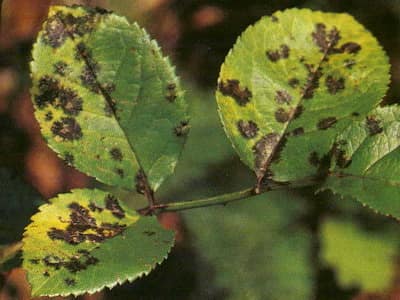

Nutrient Deficiency: Plant Disease
The lack of useful organic elements always negatively affects the appearance of the plant, its healthy and full-fledged development is impossible in conditions of a deficiency of minerals. However, everything is good in moderation and nobody canceled the rule of the "golden mean". Therefore, excess fertilization also leads to oppression of roses, due to an excess of nutrients, white spots appear on the leaves, the plant begins to gradually "wither".
In order for roses to grow beautiful, strong, spectacular and distinguished by abundant flowering, you do not need to abuse all kinds of chemical fertilizers.A correctly selected planting site, timely optimal watering and moderate competent plant feeding will provide your summer cottage with a luxurious flower garden.
Secret fertilizer for flowers
After feeding the flowers in the fall and waiting for the air temperature to drop to 5-7 ° C, you can start pruning roses, sheltering them for the winter. After the preparatory work done by you, the beautiful roses will only have to wish you a good winter and a great awakening in spring.
Important features of autumn feeding
Fertilizing roses in the fall requires compliance with several important nuances.
- It is better not to use mineral and organic nitrogen fertilizers in the fall - they can make the rose grow, and before the onset of winter this is not necessary at all.
- Care should also be taken with manure - it contains nitrogen. It is better to scatter it under rose bushes in late summer or early autumn.
- Top dressing in the fall is done twice - in early September and in October, shortly before the arrival of the first frost.
- The type of top dressing must be chosen, focusing, among other things, on the condition of the soil. If the fall is rainy, it is better to prefer dry fertilizers that do not require abundant watering.


Mineral fertilizers for roses
This type of dressing is as necessary for the growth and development of roses as organic fertilizers. Saltpeter and urea are nitrogen fertilizers that affect the formation of shoots and leaves.
Superphosphate and ammophos are phosphoric and contribute to luxurious flowering.
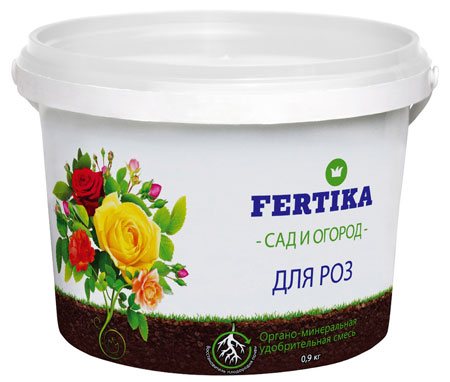

Potash fertilizers help the bushes survive the severe frosts in winter, and also help to retain moisture on the leaves and stems.
Of this group, potassium sulfate is considered the best substance; this drug is universal.
A good option is Fertika (Kemira) or Green Boom.
Foliar dressing of roses
The undoubted plus of foliar dressing is that the plants quickly receive the necessary nutrients, but the composition of the soil does not change at the same time. In order to feed the roses in autumn, 50 g of superphosphate is dissolved in 1 liter of hot water, after which another 10 liters of water is added and the leaves of the plants are sprayed.
You can also use potassium monophosphate (5 g) and superphosphate (5 g), dissolved in 10 liters of water.
Few plants love ash as much as roses. Therefore, in the fall, it will be useful to spray your beauties with an ash solution. For foliar top dressing, 200 g of ash is dissolved in 10 liters of water.
It is important to remember that spraying plants in the daytime, when the sun is especially active, can cause leaf burns. And spraying too late (after dusk) can provoke the development of a fungus, since the moisture simply does not have time to evaporate.
Topical issues of potassium magnesium for roses
Question number 1. How to feed a room rose with potassium magnesium?
Indoor rose potassium magnesium can be given in the spring and autumn in the form of a solution. It is prepared at the rate of 1.5 g per 1 liter of water. The problem in this case may arise with the dosage of the drug. Therefore, it is advisable to dilute 0.5 teaspoon of potassium magnesium in a 1.5 liter plastic bottle, then pour the required amount of solution on the potted rose. The remaining top dressing should not be stored.
Question number 2. How to measure the dosage of potassium magnesium without scales?
To do this, you need to remember that a teaspoon without a "slide" contains exactly 5 grams of potassium magnesium, a tablespoon - 15 grams, a matchbox - 20 grams. If a lot of fertilizer solution is being prepared and large doses are needed, they can be calculated based on the following information: 1 cm3 contains 1 gram of potassium magnesium. Thus, for example, in a standard faceted glass with a volume of 200 ml there will be 200 grams of granules.
Rate the quality of the article. Your opinion is important to us:
Root dressing of roses
For feeding roses before the onset of cold weather, you can use ready-made complex fertilizers. They are liquid and granular.The former are better absorbed by plants, but the latter, as a rule, have a prolonged effect, dissolving and penetrating into the soil gradually.
Also, a balanced fertilizer is easy to prepare yourself. For autumn root feeding, 16 g of potassium monophosphate and 15 g of superphosphate can be diluted in 10 liters of water. Usually this composition is enough to feed plants on an area of 4-5 sq.m.
Alternatively, you can use potassium sulfate (10 g), superphosphate (25 g) and boric acid (2.5 g), diluted in 10 liters of water. However, in this case, it is important to be extremely responsible about observing the dosages, since an excess of boric acid can cause root burns and lead to a violation of vegetation.
Fertilizing a room rose
Indoor plants are the most whimsical, so you need to be very careful with them. In these flowers, you need to fertilize both the roots and leaves.
Moreover, in the spring, when the intensive growth of the plant begins, they most of all need nitrogen and potassium. You can use both purchased and prepared independently from droppings and manure. For indoor roses, Fasco fertilizer is a good option.
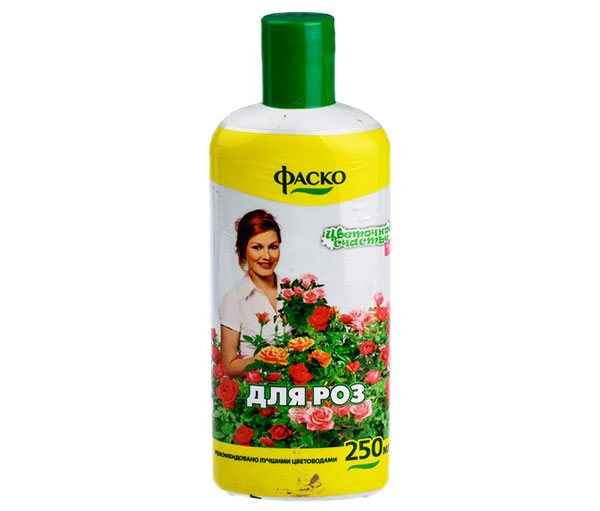

Shelf life and storage conditions
Fertilizer Kalimagnesia is not toxic, does not pose a danger in terms of explosion and fire hazard.
The shelf life is unlimited. Long shelf life of 5 years.
It should be stored in a separate place among other similar drugs.
The only condition that must be observed without fail is to protect it from water, since the product has a high degree of solubility.
A brief overview of Kalimagnesia fertilizer from the manufacturer - video
How does the drug affect the soil
A potassium-magnesium mixture will not be beneficial if used on soil types such as black soil or sulfur soil. Experiments on salt licks have also shown a negative effect.
It is worth pointing out, though, that plants such as sunflowers and sugar beets do much better when using Kalimagnesia on these soils. And development is accelerating.
The main components of potassium and magnesium fertilizers will have a beneficial effect on the land, which is classified as peat, red earth. On marshy areas kalimag is doubly necessary. The yield is increasing.
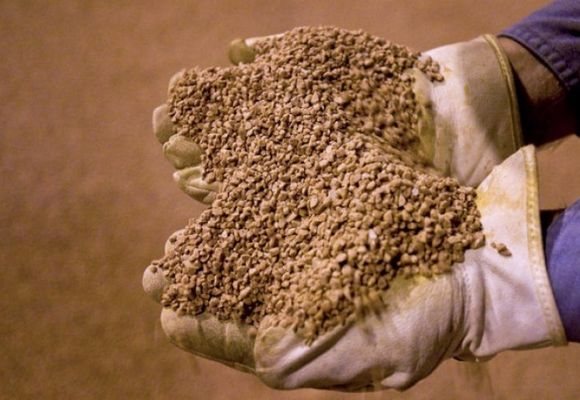

Watering indoor flowers in autumn


Watering plants is one of the most capricious procedures. Frequent watering is harmful, since the ground at the bottom of the pot does not have time to dry out and turns sour. The lower roots of plants rot and they often die.
Water the flowers that have dropped the leaves even less often, but do not allow the earthen clod to dry out. This also applies to flowers that are in a state of biological dormancy in winter: tuberous begonias, gloxinia, pomegranates.
And what should be the water? Pour it into a container in advance and keep it in the room: it will settle, lose excess chlorine, and its temperature will be equal to the surrounding air. Plants grow from excessively warm water, cold water is poorly absorbed by the roots and they can die from a lack of moisture.
Boiled water is unsuitable for irrigation, because it does not contain air.
The soil compacted after watering must be loosened.
Individual recommendations for different types of roses
Earlier in the article, a general feeding scheme was considered for all varieties of roses. But each variety has its own characteristics and problems that can be solved with the help of individual feeding.
Semi-plaited
Their peculiarity is that they have many stems and leaves. It is difficult for them to survive the winter with such an abundance of vegetative mass. Even pruning in the fall will not solve the problem. Therefore, in August, it must be heavily fed:
- nutritious complexes "Rose", "For roses";
- NPK complex fertilizers.
Before the cold weather they are well covered.
Climbing
Climbing roses love organic fertilizers. They can be fed with herbal infusions. Climbing roses also love ash and dung.From ready-made products, you can use the fertilizer "4 barrels".
Roses of Cordes
These roses decorate walls and fences. They are resistant to fungal diseases. They need foliar treatment of climbing lashes along the entire length. For this, mineral fertilizers are used, which have the property of light pesticides.
Grandiflora
Grandiflora has powerful bushes and a height of up to two meters. It needs to be well prepared for winter. Pin the vines to the ground, laying them on a pillow of spruce branches, cover them with mulch.
This rose loves slightly acidic soil. If you do not have such a land, then before planting, add manure, high peat to the soil in a couple of months.
Groundcover
These are short roses, close to the ground, so they are easily infected with fungus. To exclude this disease, they are fed with urea. In addition to the large amount of nitrogen, urea also has an antibacterial effect. Therefore, it is used in the fight against insect pests and fungal diseases.
What crops is fertilizer suitable for
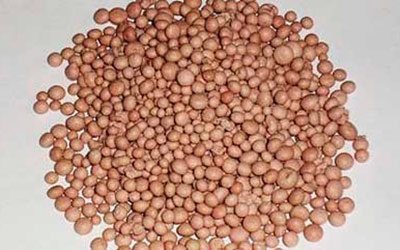

The most favorable potassium magnesia (sometimes it is somehow strangely called in two words) for:
- potatoes (1 tsp under the future bush when planting)
- carrots (1 handful per square meter)
- onions (half a handful per garden bed a week before harvest)
- cabbage (pinch under a head of cabbage in the middle of summer)
- for tomatoes (20 g per bucket of water for spraying green mass)
- beets (30 g per 1 sq. m when planted)
- for legumes and buckwheat.
Absolutely all crops respond with gratitude to feeding with this fertilizer, but root crops (turnip and radish, potatoes and beetroot, carrots and rutabagas, celery and parsnips) simply need such additional nutrition, which increases their sugar content, starch and the total dose of vitamins.
Kalimagnesia is indispensable for cucumbers, which simply cannot tolerate chlorine. Fertilizer is applied before heavy watering or rain, or vines are sprayed on the leaf throughout the summer. Dosage - half a bucket per hundred square meters. This mixture is versatile: good for both open spaces and greenhouses.
With a lack of potassium or magnesium in grapes, the bunches begin to dry out. To prevent this from happening, at least once a season (in the ripening stage), foliar feeding should be carried out. And spraying the grapes up to three times will completely solve the problem with the lack of these microelements.
If you do not want to see your coniferous plantings with pitiful yellow tops and tips of the legs, pour Kalimag (20 g) into a shallow rovik around the coniferous trunk in early spring, stepping back from the trunk itself by 40-50 cm, level the earth and spill it with plenty of water ... When the paws give "candles", repeat the process. Reviews of this application from experienced gardeners are only positive.
Related article: Potassium nitrate - reviews, description
Potassium chloride (KCL) is not recommended for feeding roses, but Kalimag would be an excellent option. The method of application is the same as for conifers, only we retreat less from the bush - only 15 cm.Pour from the watering can according to the instructions, spray the roses with the same solution before flowering (May-June) and last time in September.
I hope the article will benefit many summer residents. Therefore, do not forget to repost it, as well as subscribe to blog updates, so as not to miss new useful publications.
Precautions. First aid for poisoning
The fertilizer was assigned the III hazard class. It is low-toxic to birds and mammals, but it can harm reptiles, amphibians and insects.
During work, be sure to wear gloves and a respirator. After contact with skin, wash off immediately with plenty of water.
Kalimagnesia causes serious poisoning if it enters the gastrointestinal tract. In such a situation, you should not induce vomiting, but drink 400-600 ml of pure water with 10-15 tablets of activated carbon and consult a doctor.
conclusions
- Autumn dressing of garden roses is carried out at the end of August or in the middle of September, depending on the climate in the region.
- Fertilizers are applied by root and foliar method. The choice of a specific method depends on the state of the bush, the means.
- The main mineral fertilizers for dressing roses in the fall are potassium nitrate, superphosphate, nitrophoska and iron vitriol.
- Among the popular methods, the introduction of infusion of yeast, wood ash into the soil and watering with bird droppings are popular.
Kalimagnesia: reviews of gardeners on the use of fertilizers
Vladimir, Berdsk Hello! I want to tell you about my practice of using kalimagnesia. We grow many vegetable crops in our garden and all bear fruit perfectly, almost never get sick. Our secret is the use of Kalimagnesia. We add before planting directly into the holes for tomatoes, cucumbers, for peppers. The result is not long in coming: an excellent and tasty harvest. After they began to use this tool, the tomato harvest increased by about 30%. Recommended.
Irina Viktorovna, Moscow region Kalimagnesia is just a godsend for me. I didn't know what to do before when my favorite cucumbers started to wither in the beds. I ran to the store and bought all kinds of fertilizers. Nothing helped, as I was constantly in search of a better remedy. I also tried folk remedies. After a long search, I found kalimagnesia. I began to use it according to the instructions: apply before planting and carry out processing in spring and summer. The result simply exceeded all my expectations. All cucumbers ripen on time, very tasty.
Lyubov Aleksandrovna, Novosibirsk I always have Kalimagnesia available both at home and in the garden. At home I use it for flowers, mainly for roses and begonias. Roses do not tolerate chlorine at all, and therefore this is just an ideal top dressing. Begonias also respond well to her. In the garden, the husband always brings Kalimagnesia when digging in spring and autumn. Thanks to this, the harvest of our horticultural crops is always happy.
Choosing the right fertilizers!
Potassium monophosphate: fertilizer composition and use in the garden and in the garden
Description and properties of the drug
Magnesium fertilizer Kalimagnesia or Kalimag has gained popularity due to its beneficial qualities. This includes not only the composition, but also the duration of storage, ease of use. The appearance of Kalimagnesia differs from the mass of drugs that are offered in stores:
- shade - gray-pink;
- form - granules;
- solubility - fast without sediment;
- smell - absent.
Distinctive properties of Kalimagnesia are storage duration without caking, without loss of useful qualities. Recommended for mineral-poor soils:
- potassium;
- magnesium;
- sulfur.
Suitable for use on soil types such as:
- red and floodplain;
- sandstones and peat bogs;
- sandy loam.
The result of the application is an increase in yield, an improvement in soil quality. It also has a beneficial effect on the structural restoration of the soil. The substance is suitable for most crops (even chlorophobic ones). This became possible due to the unique and environmentally friendly composition.
Humates
Humates are a new class of agricultural chemicals. Research on this topic has not yet been completed.
Humates are sodium and potassium salts of humic acids. Humic acids were first found in soil humus. Humus is formed by the decomposition of soil organic matter by soil microbes.
Humates are industrial and natural. In plant growing, only natural ones are used, obtained from natural organic deposits. Outwardly, they differ from industrial ones.
Ballastless natural humates are moist, lumpy, black or brown. They are used as growth stimulants and restorative agents for roses and other plants.
Ballast humates are on sale.They are granules of complex fertilizers covered with a humate shell. On the packaging of such drugs, they write "Gumat NPK". It works well after pruning roses.
Potassium humate
Potassium humate is chemically neutral. Its pH is 7-8. Therefore, it can be safely used on different soils. It is effectively used when processing cuttings of roses for rooting, their survival rate becomes much higher. For sale humates enriched with microelements. On such packages there is an inscription - "Potassium humate +7".
Sodium humate
It is undesirable to use this drug on alkaline soils, since its pH is almost 10. But it is more effective than potassium humate in cases where it is necessary:
- protect the plant from pests;
- help him survive the drought;
- increase resistance to freezing;
- to reduce the dropping of leaves and buds.
What is the difference
There is no big difference in the effect of these drugs on plants. They are interchangeable. You just need to take into account the nature of the soil in your garden. If it is alkaline, then it is better to use potassium humate.
Do not use humates in conjunction with phosphorus fertilizers and calcium nitrate. In this case, insoluble compounds are formed. It is necessary to carry out separate feeding. First, humates are introduced into the moist soil, and after five days the necessary fertilizer.
Effect on plants
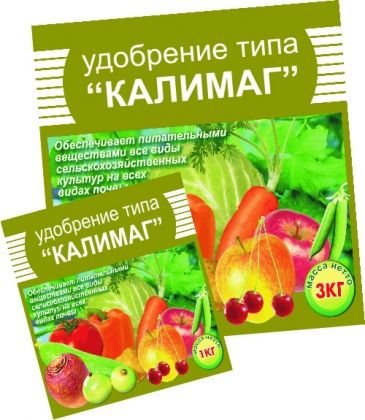

Potassium in the composition of "Kalimaga" increases the immunity of plants. Crops become more resistant to diseases, pests and fungi, they tolerate frosts more easily. The ripening of fruits is accelerated, the yield and the period of fruiting are significantly increased.
Magnesium is an essential trace element responsible for the production of energy by the plant organism. With its deficiency, the root system of plants suffers first of all. Plants synthesize sugar from the ultraviolet rays of sunlight and water, which is further responsible for the structure and accumulation of carbohydrates, such as starch and cellulose. This is the reason why magnesium is so important for potatoes, legumes and cereals.
Magnesium deficiency is not noticeable for a long time. It can be determined by the state of the old, lower leaves, which turn yellow and curl prematurely.
It is more difficult to determine the shortage by young foliage, since it is in the young growth that this microelement is concentrated. Magnesium is responsible for transporting nutrients. With its lack, the root system becomes depressed. The plant develops poorly, absorbs moisture worse, and this reduces drought resistance and can lead to sunburn.
Sulfur enhances metabolism, is responsible for the recovery processes in any living organism, promotes the absorption of nitrogen, the formation of protein. Cruciferous plants such as cabbage and turnips consume large amounts of sulfur during the growing season as they are high protein vegetables.
Sulfur starvation resembles a lack of nitrogen in its characteristics.
... Plants do not develop well, look weak, leaves become small, and cuttings and shoots are woody to the touch. The color of the leaves becomes faded. It is possible to distinguish between nitrogen and sulfur starvation only on one basis. With a lack of sulfur, the vegetative mass does not die off; with nitrogen, leaves fall off. The use of potassium magnesium helps to solve the problem of deficiency of three elements.
Peat, floodplain, swampy soils, as well as red soils, contain a small amount of magnesium, but are deficient in sulfur and potassium. Therefore, on these types of soils, the use of potassium magnesium will also become effective.
On loamy, forest soils and leached chernozems, a double sulfate substrate will be effective with sufficient moisture. On all types of chernozems, "Kalimag" is usually not used, as these soils contain enough potassium.With a deficiency of sulfur and magnesium, potassium magnesium can be used, although on chernozems, the use of magnesium sulfate will become more justified.
What is potassium magnesium
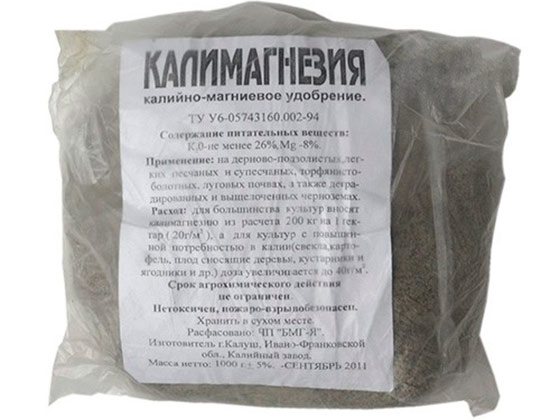

They bring it into dry land, and in solution, and simply throughout the entire territory of digging a site in spring or autumn. If potassium magnesium itself has the form of a light gray-brick powder, then "Kalimag" is produced by the industry in the form of granules, which have a composition of K2O - from 26%, MgO - from 4%. Reasonable application makes it possible to predict a yield 30-40% higher than growing crops without potassium magnesium.
Increasing the yield of the garden and vegetable garden is what potassium magnesium fertilizer is used for. It is also universal in application: almost always - 20 g per bucket of water or the same amount per 1 sq. m.
The benefits of indoor plants for humans
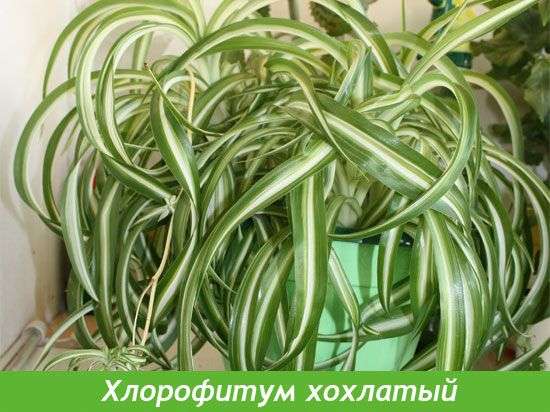

All indoor plants emit oxygen, humidify the air of our homes, and have a bactericidal effect. For example, after 3 weeks of staying in the room of a Chinese rose, sansevier, laurel or lemon, it is almost completely cleared of most pathogenic microbes.
Air purity in any apartment is also far from the desired one. Modern paints and varnishes of furniture, carpets, various synthetic products significantly pollute the surrounding air with their vapors. When using natural gas, large amounts of carbon monoxide and nitrogen dioxide are emitted during cooking. Tobacco smoke also contributes to air pollution. All this makes one think about air purification in apartments, especially in the winter months, when in order to preserve heat, living quarters are practically deprived of natural air exchange.
The true record holder among "natural filters" is Crested Chlorophytum - a native of South Africa. It has been experimentally proven that if you place 5-6 such plants in a room, then the purity of the air in it will approach the air of a hospital operating room.
Taking care of your indoor plants in the fall can be a little trickier than other times, but it's worth it!
Fertilizer analogues and joint use with other substances
In the absence of Kalimagnesia in stores, it is impossible to find a substitute. There are simply no analogues.
Even if the fertilizer offered by the seller contains magnesium or potassium, it is not classified as similar. This is due to balanced processes that occurred naturally. Top dressing is considered unique.
Kalimagnesia has a low compatibility with fertilizers. With such as urea, biostimulants or simply growth stimulants cannot be categorically combined.


Effect on horticultural crops
In the complex, all the components of "Kalimagnesia" have an effective effect on the quantity and quality of the crop, and also have a beneficial effect on the soil. What happens after you have watered the garden with this fertilizer, let's figure it out in detail using the example of each component.
Potassium is responsible for enhancing the protective functions of plant organisms. Having received this element, plants acquire immunity to pathogenic bacteria and viruses, resist the defeat of fungal spores, and survive the winter cold more easily. Revitalized ovaries initiate rapid maturation.
The fruits are characterized by high gustatory and commercial qualities.
Magnesium takes over the energy release from plants. In cases of deficiency of this trace element, a certain lifeless state of the stems and foliage is observed. This is due to the suffering root system.
Botanists explain that under the influence of sunlight and sufficient soil moisture in the fibers of the plant, sugars are synthesized, which further affects the amount of carbohydrates, fructose, cellulose, and starch. Therefore, the element is of particular importance for cereals, beans, etc.
Important!
The lack of magnesium cannot be noticed immediately. The lifelessness of the stems manifests itself already in critical situations.Pay attention to the foliage below. With a sufficient amount of a trace element, it should not be yellow and twisted.
In addition, magnesium is assigned the function of uniform distribution of nutrients through plant tissues. If a failure occurs, the plant does not absorb water well when watering, stops growing, often sunburns appear on the stems.
Sulfur, as an auxiliary component, is responsible for the restoration of cells and fibers, as well as for the absorption of nutrients and the formation of proteins. It is of particular importance for vegetable crops. With its lack, growth deterioration is observed, the shoots are weakened, the leaves are small and undeveloped, the cuttings are woody. Many gardening enthusiasts mistakenly think that these are signs of nitrogen starvation, since there are many similarities between them. The essential and, perhaps, the only difference is that with a sulfur deficiency, the foliage does not fall off, as with a lack of nitrogen.
Did you know?Potash fertilizers are made from raw potassium salts, which are mined in Canada, Belarus and Russia.

